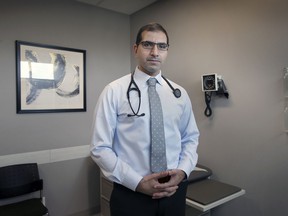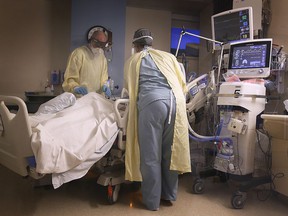
Article content
Dr Wassim Saad, Chief of Staff at Windsor Regional Hospital, says Omicron’s preliminary stages in the area have revealed a variant that affects the local population differently based on age and vaccination status than the previous waves of COVID-19.
Commercial
This ad has not been uploaded yet, but your article continues below.
Article content
While those who are partially vaccinated or unvaccinated continue to see infections and the resulting hospitalizations spread across the board from age zero onwards, those who are vaccinated and under 60 have seen their chances of ending up in hospital reduced.
“If you look at what is happening with Omicron in the rest of the province and the world, if you are fully vaccinated, you have less than one percent chance of ending up in ICU or dying from COVID,” Saad said.
Saad said a Thursday snapshot of age-based data from the hospital itself mirrors the picture seen elsewhere. At that time, there were only three hospitalizations of patients under 60 years old among those vaccinated and zero cases under 40 years old among the total of 19 vaccinated patients.
Commercial
This ad has not been uploaded yet, but your article continues below.
Article content
Of the 12 unvaccinated or partially vaccinated patients in the hospital mainly for COVID, five were under 60 years old, two of them were under 40 and one was between zero and nine years old.
“If you are not vaccinated, you can see the trend from zero to nine all the way up to people aged 80 to 89 evenly distributed similar to what we were seeing in previous waves,” Saad said. “People need to recognize that.”
What these vaccines do is prevent serious and significant illness and hospitalizations and prevent deaths.
Saad said another different aspect of Omicron is the demographics of vaccinated patients who need hospitalization. “In the first two waves, we were admitting people in their 20s, 30s and 40s who had almost no comorbidities,” Saad said.
“What we are seeing right now with those who are fully vaccinated, those who were admitted to the hospital had significant comorbidities. We are talking about transplant patients, patients with multiple problems such as blood pressure, diabetes, cholesterol, heart disease ”.
Commercial
This ad has not been uploaded yet, but your article continues below.
Article content
With an increase in new cases over the weekend, the number of people at Windsor Regional rose to 67 on Monday.
Forty-five of those people were being treated primarily for COVID-19, with 25 fully vaccinated, four partially vaccinated, and 16 unvaccinated. Seven of the 10 people in intensive care are not vaccinated or partially vaccinated.
Saad added that the similarity in the number of vaccinated and unvaccinated or partially vaccinated patients is also misleading. The 25 vaccinated patients come from 80 percent of the local population that have been fully vaccinated versus a similar number of just 20 percent.
“Clearly, the percentages and the chance that you end up in the hospital vary significantly depending on whether you are fully vaccinated, partially vaccinated or completely unvaccinated,” Saad said.
Commercial
This ad has not been uploaded yet, but your article continues below.
Article content
Saad added that it is a myth that vaccines have failed if they allow infections. He explained that the vaccines are meant to combat the worst-case scenario of ending up in ICU.

In Ontario, 9,706 new cases of Omicron were reported Monday with 438 ICU patients. By comparison, at the height of the previous wave on May 1, 2021, before an extensive vaccine rollout, 2304 cases were reported that day with 828 patients in the ICU.
“These are not what we call sterilizing vaccines,” Saad said. “Sterilizing the vaccine will prevent you from getting an infection in the first place.
-
Jarvis: There is hope, use it to strengthen yourself and find joy wherever you can this Christmas
-
WRH Chief of Staff urges booster injection in fight against Omicron
“There are very few vaccines that do that. What these vaccines do is prevent serious and significant illness and hospitalizations and prevent deaths.
“There is no question that these vaccines are doing that by keeping vaccinated patients out of our ICUs.”
Reference-windsorstar.com

